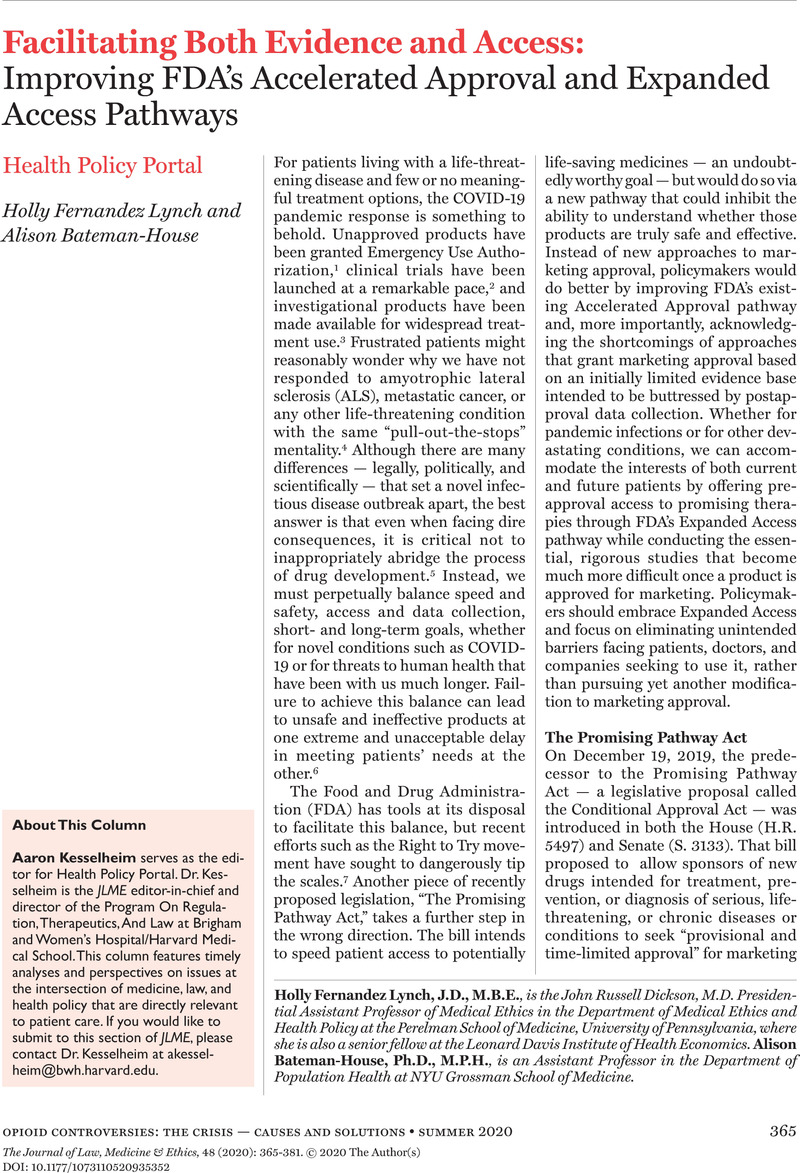Crossref Citations
This article has been cited by the following publications. This list is generated based on data provided by Crossref.
Webb, Jamie
Shah, Lesha D.
and
Lynch, Holly Fernandez
2020.
Ethically Allocating COVID-19 Drugs Via Pre-approval Access and Emergency Use Authorization.
The American Journal of Bioethics,
Vol. 20,
Issue. 9,
p.
4.
Kilbride, Madison
Joffe, Steven
and
Lynch, Holly Fernandez
2020.
Prescription Requirements and Patient Autonomy: Considering an Over‐the‐Counter Default.
Hastings Center Report,
Vol. 50,
Issue. 6,
p.
15.
Kinch, Michael S.
Kraft, Zachary
and
Schwartz, Tyler
2021.
2020 in review: FDA approvals of new medicines.
Drug Discovery Today,
Vol. 26,
Issue. 12,
p.
2794.
Lynch, Holly Fernandez
Caplan, Arthur
Furlong, Patricia
and
Bateman-House, Alison
2021.
Helpful Lessons and Cautionary Tales: How Should COVID-19 Drug Development and Access Inform Approaches to Non-Pandemic Diseases?.
The American Journal of Bioethics,
Vol. 21,
Issue. 12,
p.
4.
ASHIQUE, SUMEL
and
KHATUN, TAHAMINA
2021.
COMPASSIONATE USE OF INVESTIGATIONAL DRUG DURING EMERGENCY CONDITIONS AND ASSOCIATED ETHICAL ASPECTS, CHALLENGES, AND BENEFITS.
Asian Journal of Pharmaceutical and Clinical Research,
p.
5.
Largent, Emily A.
Peterson, Andrew
and
Lynch, Holly Fernandez
2021.
FDA Drug Approval and the Ethics of Desperation.
JAMA Internal Medicine,
Vol. 181,
Issue. 12,
p.
1555.
Halley, Meghan C.
2021.
From “Ought” to “Is”: Surfacing Values in Patient and Family Advocacy in Rare Diseases.
The American Journal of Bioethics,
Vol. 21,
Issue. 12,
p.
1.
Lynch, Holly Fernandez
and
Robertson, Christopher T.
2021.
Challenges in confirming drug effectiveness after early approval.
Science,
Vol. 374,
Issue. 6572,
p.
1205.
Smith, E.M.
Anderson, E.E.
Deer, R.
Prochaska, J.
Bohn, K.
and
Croisant, S.
2022.
Reviewing fair subject selection considerations for the unique case of post sequelae COVID-19 translational studies.
Journal of Clinical and Translational Science,
Vol. 6,
Issue. 1,
Smith, William R.
and
Appelbaum, Paul S.
2022.
Novel ethical and policy issues in psychiatric uses of psychedelic substances.
Neuropharmacology,
Vol. 216,
Issue. ,
p.
109165.
Zuckerman, Shlomit
Barlavie, Yaron
Niv, Yaron
Arad, Dana
and
Lev, Shaul
2022.
Accessing unproven interventions in the COVID-19 pandemic: discussion on the ethics of ‘compassionate therapies’ in times of catastrophic pandemics.
Journal of Medical Ethics,
Vol. 48,
Issue. 12,
p.
1000.
Lynch, Holly Fernandez
and
Largent, Emily A
2023.
Considering tomorrow’s patients in today’s drug approvals.
BMJ,
p.
e075000.
Nelson, Ryan H.
Moore, Bryanna
Lynch, Holly Fernandez
Waggoner, Miranda R.
and
Blumenthal-Barby, Jennifer
2023.
Bioethics and the Moral Authority of Experience.
The American Journal of Bioethics,
Vol. 23,
Issue. 1,
p.
12.
Zettler, Patricia J.
Ikonomou, Laertis
Levine, Aaron D.
Turner, Leigh
Grilley, Bambi
and
Roxland, Beth E.
2023.
An International Society for Cell & Gene Therapy working group short report on the future of expanded access to unapproved cell and gene therapies.
Cytotherapy,
Vol. 25,
Issue. 7,
p.
712.
Patel, Neeraj G.
Kesselheim, Aaron S.
and
Darrow, Jonathan J.
2023.
Trust and Regulation: Assuring Scientific Independence in the FDA's Emergency Use Authorization Process.
Journal of Health Politics, Policy and Law,
Vol. 48,
Issue. 5,
p.
799.
Mercuri, Mathew
Hackett, Kristy
Upshur, Ross
and
Emerson, Claudia Isabel
2023.
Expediting approval for medical countermeasures to address high burden disease: an ethical justification to move beyond emergency use authorisation.
BMJ Global Health,
Vol. 8,
Issue. 11,
p.
e013480.
Mastroleo, Ignacio
and
Daly, Timothy
2023.
Handbook of Bioethical Decisions. Volume II.
Vol. 3,
Issue. ,
p.
343.
Miller, Susan
Moos, Walter
Munk, Barbara
Munk, Stephen
Hart, Charles
and
Spellmeyer, David
2023.
Managing the Drug Discovery Process.
p.
417.
Bhattacharyya, Mehul
Miller, Larry E
Miller, Anna L.
and
Bhattacharyya, Ruemon
2024.
The FDA approval of delandistrogene moxeparvovec-rokl for Duchenne muscular dystrophy: a critical examination of the evidence and regulatory process.
Expert Opinion on Biological Therapy,
Vol. 24,
Issue. 9,
p.
869.
Sharma, Rohini
Gulati, Anamika
and
Chopra, Kanwaljit
2025.
Era of surrogate endpoints and accelerated approvals: a comprehensive review on applicability, uncertainties, and challenges from regulatory, payer, and patient perspectives.
European Journal of Clinical Pharmacology,



